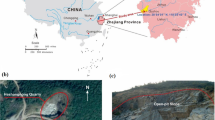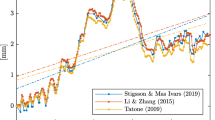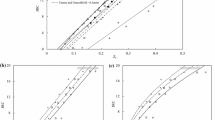Abstract
The variogram method is used to investigate the effect of non-stationarity, heterogeneity, scale-related parameters and anisotropy on roughness quantification of a natural rock joint of size 1 m × 1 m. The methodology quantifies two parameters to capture the stationary roughness. The effect of the non-stationarity of the used profiles was found to be negligible on the computed fractal parameters. Calculated fractal parameter values reflected significant heterogeneity on one part of the roughness surface compared to the rest of the surface studied in the paper. Effect of joint size was found to be negligible on the calculated fractal parameter values. The authors believe that the controversial findings appear in the literature on scale effects have resulted from roughness heterogeneity, which has not been investigated in detail in the literature in quantifying roughness. Rock discontinuity surface showed major anisotropy with respect to roughness. Roughness in the direction along the axis of ridges and troughs (X-direction) of the joint surface was found to be significantly less compared to that in the direction perpendicular to the direction of axis of ridges and troughs. Thus, it agreed with the intuition that the discontinuity resulted from a shear fracture with the main shearing direction approximately parallel to the X direction.



















Similar content being viewed by others
Availability of data and material
Possibility exists to make data available after publishing the papers in journals. Please contact the corresponding author.
Code availability
Possibility exists to make the code available after publishing the papers in journals. Please contact the corresponding author.
References
Aydan Ö, Shimizu Y, Kawamoto T (1996) The anisotropy of surface morphology characteristics of rock discontinuities. Rock Mech Rock Eng 29(1):47–59
Bandis S, Lumsden AC, Barton NR (1981) Experimental studies of scale effects on the shear behaviour of rock joints. Int J Rock Meck Min Sci Geomech Abstr 18(1):1–21
Barton N (1973) Review of a new shear-strength criterion for rock joints. Eng Geol 7(4):287–332
Belem T, Etienne FH, Souley M (2000) Quantitative parameters for rock joint surface roughness. Rock Mech Rock Eng 33(4):217–242
Berry MV, Lewis ZV (1980) On the Weierstrass-Mandelbrot fractal function. Proceedings of the Royal Society of LondonSeries A 370(1743):459–484
Brown SR (1995) Simple mathematical model of a rough fracture. J Geophys Res 100(B4):5941–5952
Brown SR, Scholz CH (1985) Broad bandwidth study of the topography of natural rock surface. J Geophys Res 90(B14):12575–12582
Cravero M, Iabichino G, Ferrero AM (2001) Evaluation of joint roughness and dilatancy of schistosity joints. In: Sarkka P, Eloranta P (eds) Rock mechanics-a challenge for society; Proceedings of Eurock Espoo, Finland, AA Balkema, Rotterdam 217–222
Cravero M, Iabichino G, Piovano V (1995) Analysis of large joint profiles related to rock slope instabilities. In: Proceedings of the 8th ISRM Congress, Tokyo, Japan, AA Balkema, Rotterdam 423–428
Develi K, Babadagli T, Comlekci C (2001) A new computer-controlled surface-scanning device for measurement of fracture surface roughness. Comput Geosci 27(3):265–277
Du S (1998) Research on complexity of surface undulating shapes of rock joints. J China Univ Geo 9:86–89
Du S, Hu Y, Hu X (2009) Measurement of joint roughness coefficient by using profilograph and roughness ruler. J Earth Sci 20(5):890–896
Du S, Du K, Yong R, Ye J, Luo Z (2021) Scale effect on the anisotropy characteristics of rock joint roughness. Q J Eng Geol Hydrogeol. https://doi.org/10.1144/qjegh2020-066
El-Soudani SM (1978) Profilometric analysis of fractures. Metallography 11(3):247–336
Fardin N (2008) Influence of structural non-stationarity of surface roughness on morphological characterization and mechanical deformation of rock joints. Rock Mech Rock Eng 41(2):267–297
Fardin N, Feng Q, Stephansson O (2004) Application of a new in situ 3D laser scanner to study the scale effect on the rock joint surface roughness. Int J Rock Mech Min Sci 41(2):329–335
Fardin N, Stephansson O, Jing L (2001) The scale dependence of rock joint surface roughness. Int J Rock Mech Min Sci 38(5):659–669
Fecker E, Rengers N (1971) Measurement of large-scale roughness of rock planes by means of profilograph and geological compass. Rock fracture. In: Proceeding of the 1st ISRM Symposium, Nancy, France 1–18
Feder J (1988) Fractals. New York: Plenum Press 1988
Feng Q, Fardin N, Jing L, Stephansson O (2003) A new method for in-situ non-contact roughness measurement of large rock fracture surfaces. Rock Mech Rock Eng 36(1):3–25
Ge YF, Kulatilake PHSW, Tang HM, Xiong C (2014) Investigation of natural rock joint roughness. Comput Geotech 55:290–305
Grasselli G, Wirth J, Egger P (2002) Quantitative three-dimensional description of a rough surface and parameter evolution with shearing. Int J Rock Mech Min Sci 39(6):789–800
Hong ES, Lee JS, Lee IM (2008) Underestimation of roughness in rough rock joints. Int J Numer Anal Meth Geomech 32(11):1385–1403
Hsiung SM, Ghosh A, Ahola MP, Chowdhury AH (1993) Assessment of conventional methodologies for joint roughness coefficient determination. Int J Rock Mech Min Sci Geomech Abstr30:825–829
Huang SL, Oelfke SM, Speck RC (1992) Applicability of fractal characterization and modelling to rock joint profiles. Int J Rock Mech Min Sci Geomech Abstr29(2):89–98
ISRM (1978) International Society for Rock Mechanics commission on standardization of laboratory and field tests: suggested methods for the quantitative description of discontinuities in rock masses. Int J Rock Mech Min Sci Geomech Abstr 15(6):319–368
Jiang YJ, Li B, Tanabashi Y (2006) Estimating the relation between surface roughness and mechanical properties of rock joints. Int J Rock Mech Min Sci 43(6):837–846
Kodikara JK, Johnston IW (1994) Shear behaviour of irregular triangular rock -concrete joints. Int J Rock Mech Min Sci Geomech Abstr31(4):313–322
Kulatilake PHSW, Balasingam P, Park J, Morgan R (2006) Natural rock joint roughness quantification through fractal techniques. Geotech Geol Eng 24:1181–1202
Kulatilake PHSW, Park J, Morgan Balasingam P, R, (2008) Quantification of aperture and relations between aperture, normal stress and fluid flow for natural single rock fractures. Int Jour of Geotech and Geological Engg 26(3):269–281
Kulatilake PHSW, Shou G, Huang TM, Morgan RM (1995) New peak shear strength criteria for anisotropic rock joints. Int J Rock Mech Min Sci Geomech Abstr32:673–697
Kulatilake PHSW, Um J (1999) Requirements for accurate quantification of self-affine roughness using the roughness-length method. Int J Rock Mech Min Sci 36(1):5–18
Kulatilake PHSW, Um J, Pan G (1997) Requirements for accurate estimation of fractal parameters for self-affine roughness profiles using the line scaling method. Rock Mech Rock Eng 30(4):181–206
Kulatilake PHSW, Um J, Pan G (1998) Requirements for accurate quantification of self-affine roughness profiles using variogram method. Int J Solids Struct 35(31):4167–4189
Kulatilake PHSW, Um J, Panda BB, Nghiem N (1999) Development of a new peak shear strength criterion for anisotropic rock joints. J Eng Mech 125(9):1010–1017
Lanaro F (2000) A random field model for surface roughness and aperture of rock fractures. Int J Rock Mech Min Sci 37(8):1195–1210
Lanaro F, Jing L, Stephansson O (1998) 3D-laser measurements and representation of roughness of rock fractures. In: Proceeding of Mechanics of Jointed and Faulted Rock, Rotterdam 185–189
Lanaro F, Jing L, Stephansson O (1999) Scale dependency of roughness and stationarity of rock joints. In: Vouille G, Berest P (eds) Proceedings of the 9th congress of ISRM, Paris, France 1391–1395
Leal-Gomes MJA (2003) Some new essential questions about scale effects on the mechanics of rock joints. In: Handley M (ed) Proceedings of the 10th ISRM Congress: Technology roadmap for rock mechanics, Sandton, South Africa, South African Institute of Mining and Metallurgy 721–727
Maerz NH, Franklin JA, Bennett CP (1990) Joint roughness measurement using shadow profilometry. Int J Rock Mech Min Sci Geomech Abstr 27:329–343
Malinverno A (1990) A simple method to estimate the fractal dimension of a self-affine series. Geophys Res Lett 17(11):1953–1956
Mandelbrot BB (1967) How long is the coast of Britain? Statistical Self-Similarity and Fractional Dimension Science 156(3775):636–638
Matsushita M, Ouchi S (1989) On the self-affinity of various curves. Physica D 38(1):246–251
Miller SM, McWilliams PC Kerkering JC (1990) Ambiguities in estimating fractal dimensions of rock fracture surfaces. In: Proceeding of the 31st U.S. Symposium on Rock Mechanics, Rotterdam 471–478
Myers NO (1962) Characterization of surface roughness. Wear 5(3):182–189
Odling NE (1994) Natural fracture profiles, fractal dimension and joint roughness coefficient. Rock Mech Rock Eng 27(3):135–153
Orey S (1970) Gaussian simple functions and Hausdorff dimension of level crossing. Zeitschrift Für Wahrscheinlichkeitstheorie Und Verwandte Gebiete 15(3):249–256
Poon CY, Sayles RS, Jones TA (1992) Surface measurement and fractal characterization of naturally fractured rocks. J Phys D Appl Phys 25(8):1269–1275
Power WL, Tullis TE (1991) Euclidean and fractal models for the description of rock surface roughness. J Geophys Res 96(B1):415–424
Rasouli V, Harrison JP (2000) Scale effect, anisotropy and directionality of discontinuity surface roughness. Proceeding of EUROCK National Symposium for Felsmechanik Und Tunnelbau, Aachen, Germany 14:751–756
Russ JC (1994) Fractal surfaces. Springer
Sayles RS, Thomas TR (1977) The spatial representation of surface roughness by means of the structure function: a practical alternative to correlation. Wear 42(2):263–276
Shirono T, Kulatilake PHSW (1997) Accuracy of the spectral method in estimating fractal / spectral parameters for self-affine roughness profiles. Int J Rock Mech Min Sci 34(5):789–804
Swan G, Zongqi S (1985) Prediction of shear behaviour of joints using profiles. Rock Mech Rock Eng 18(3):183–212
Tatone BSA, Grasselli G (2013) An investigation of discontinuity roughness scale dependency using high-resolution surface measurements. Rock Mech Rock Eng 46(4):657–681
Tse R, Cruden DM (1979) Estimating joint roughness coefficients. Int J Rock Mech Min Sci Geomech Abstr 16(5):303–307
Wu TH, Ali EM (1978) Statistical representation of the joint roughness. Int J Rock Mech Min Sci Geomech Abstr15(5):259–262
Xie HP, Wang JA, Xie WH (1997) Fractal effects of surface roughness on the mechanical behavior of rock joints. Chaos, Solitons Fractals 8(2):221–252
Yong R, Ye J, Du LB, S, (2018) Determining the maximum sampling interval in rock joint roughness measurements using Fourier series. Int J Rock Mech Min Sci 101:78–88. https://doi.org/10.1016/j.ijrmms.2017.11.008
Yu XB, Vayssade B (1991) Joint profiles and their roughness parameters. Int J Rock Mech Min Sci Geomech Abstr28(4):333–336
Zhang X, Jiang Q, Chen N, Wei W, Feng X (2016) Laboratory investigation on shear behavior of rock joints and a new peak shear strength criterion. Rock Mech Rock Eng 49:3495–3512. https://doi.org/10.1007/s00603-016-1012-2
Funding
The first author received financial supports from the Distinguished Foreign Expert Talent Program Funding. The work was funded by National Natural Science Foundation of China (grant number 41427802 for Prof. Du and grant number 41502300 for Prof. Yong), Zhejiang Provincial Natural Science Foundation (grant number LQ16D020001 for Prof. Yong), Zhejiang Collaborative Innovation Center for Prevention and Control of Mountain Geological Hazards (grant number ZJRMG-2018-Y-03 for Prof. Yong). Also, Dr. Rui Wu received financial support from the National Natural Science Foundation of China through grant number 51604126.
Author information
Authors and Affiliations
Corresponding author
Ethics declarations
Competing interests
The authors declare that no competing interests.
Additional information
Highlights
1. Roughness of a fairly large size (1 m × 1 m) natural rock joint is quantified.
2. Roughness heterogeneity, which is rarely addressed in the rock mechanics literature, is addressed in detail by performing more than 1700 computations.
3. Controversial findings appear in the literature on roughness scale effect due to joint size is clarified through systematic quantification and interpretation.
4. Roughness anisotropy is clearly shown for a discontinuity resulted from a natural shear fracture.
5. Reliability of the variogram technique as an accurate roughness quantification method is shown through more than 1700 consistent computations.
Rights and permissions
About this article
Cite this article
Kulatilake, P.H.S.W., Du, SG., Ankah, M.L.Y. et al. Non-stationarity, heterogeneity, scale effects, and anisotropy investigations on natural rock joint roughness using the variogram method. Bull Eng Geol Environ 80, 6121–6143 (2021). https://doi.org/10.1007/s10064-021-02321-3
Received:
Accepted:
Published:
Issue Date:
DOI: https://doi.org/10.1007/s10064-021-02321-3




